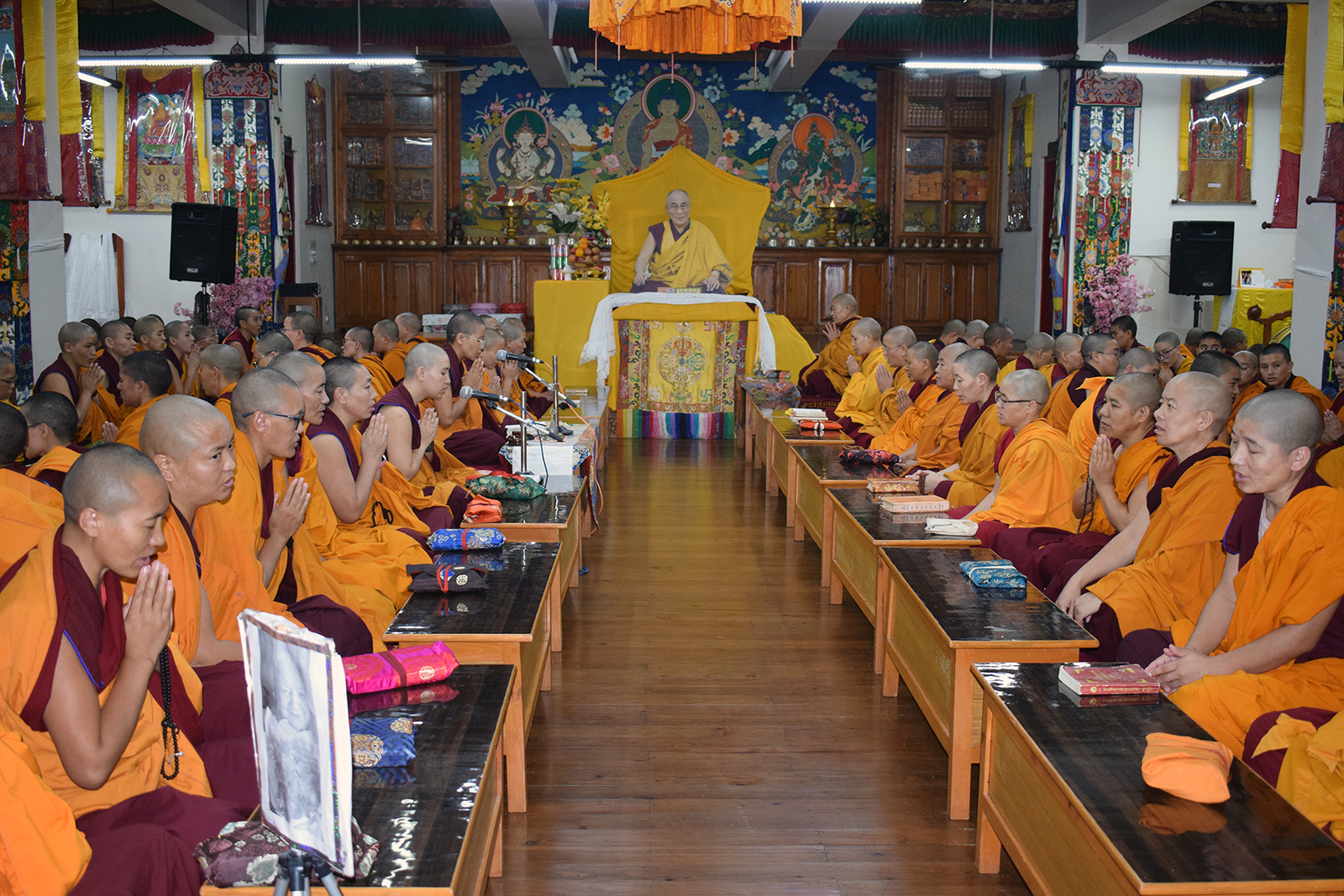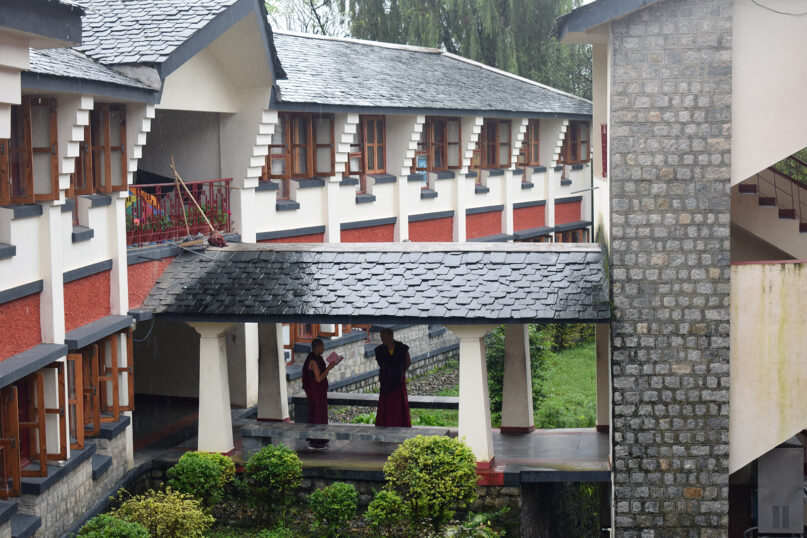
DHARAMSHALA, India (RNS) — When Geshema Delek Wangmo was 12 years old and starting her Tibetan Buddhist journey, she joined her teacher on a pilgrimage.
The journey, which involved traveling on foot from the high-altitude town of Litang in the Kham region of Tibet to Lhasa in a valley of the Himalayas — both spiritually significant locations in Tibetan Buddhism — required her to beg in villages, sleep in tents, embark on meditative practices and live with villagers who offered the monastics vegetables, butter, cheese and milk for their sustenance. A year-and-a-half later, the young nun traveled hundreds of miles, enduring harsh weather and terrain, to reach Kailash, a sacred mountain in the Tibetan Autonomous Region.
Now, Wangmo, 44, is the first woman principal of a nunnery in north India’s Dharamshala, home to the Dalai Lama and the Tibetan government-in-exile. In April, when the nonsectarian Dolma Ling Nunnery transitioned to female academic leadership for the first time in its three-decade history, it marked a radical shift in the landscape of Tibetan Buddhism in exile.
“If more women take on leadership roles in religion, there’ll be a spurt in positive thinking, compassion and quality of education,” said Wangmo, who came to the nunnery in 1990.
Along with two senior nuns in charge of the nunnery’s administration, Wangmo is showing more than 270 nuns from various lineages what’s possible for women in religion today.
“Geshema has gone through many hardships and understands the inner world of nuns,” said 30-year-old Tenzin Dolma, who arrived at the nunnery five years ago from a Tibetan refugee settlement in Kathmandu, Nepal. “She’s inspiring younger nuns to think big and aim high.”

The new academic principal of the Dolma Ling Nunnery, Geshema Delek Wangmo, left, with English teacher Tsering Norbu in Dharamshala, India, Sept. 1, 2025. (Photo by Priyadarshini Sen)
Nestled in the foothills of the Lesser Himalayas and surrounded by the snow-capped Dhauladhar peaks, the Dolma Ling Nunnery’s compact red and white buildings, set around a central courtyard, was inaugurated by the Dalai Lama in 2005. Surrounded by lush, landscaped flower and vegetable gardens, Wangmo urges the nuns to apply Buddhist principles in their daily lives. In their classrooms dedicated to studying Buddhist philosophy, dialectics, Tibetan language and ritual arts, she instructs them on the spiritual development of the community.
“In traditional society, female monastics prayed and recited from holy scriptures,” said Nangsa Chodon, director of the Tibetan Nuns Project, a nonprofit based in Seattle and Dharamshala that supports refugee nuns from Tibet and India’s Himalayan regions. “But now, the Dalai Lama is helping nuns become leaders in their own nunneries.”
From the late 1980s to early 2000s, many Tibetans who had been marginalized through occupation escaped on foot over the Himalayas to Dharamshala. Many feared torture and persecution like their forefathers faced between 1949 and 1950, when independent Tibet was invaded by China. In exile, many Tibetans wanted to practice Buddhism, the religion woven into the fabric of their society, influencing their daily routines and worldview.
“Initially, it was just survival for the nuns and monks who fled to India,” said Venerable Ngawang Palmo, who is in charge of the nunnery’s administration. “But now, education is being emphasized so that it fosters equality in the monastic community and beyond.”

Buddhist nuns study in the red-and-white corridors of the Dolma Ling Nunnery in Dharamshala, India, Sept. 1, 2025. (Photo by Priyadarshini Sen)
For nuns, the Geshema degree is the highest academic title, awarded after 17 years of studying five great canonical texts of Tibetan Buddhism. The degree — which allows nuns to receive public recognition as teachers and leaders in the Buddhist world — was first approved for women in 2012, previously only available to monks. Four years later, 20 nuns were recognized as Geshema by the Dalai Lama, who many credit for allowing women to take on leadership and teaching roles previously reserved for monks.
“Now with women in leadership roles, the monastic community has been infused with fresh energy,” said Gyurmey Dorjey, a monk who has been teaching Buddhist philosophy at Dolma Ling for 18 years.
Dorjey attributes the shift to the Tibetan Nuns Project’s founding director, Rinchen Khando Choegyal. A founding member of the Tibetan Women’s Association and the Dalai Lama’s sister-in-law, Choegyal promoted social, political and economic equality among Tibetans in exile and is credited with informing the international community about the plight of Tibetan refugees, Dorjey said. At Dolma Ling, she encouraged the nuns to grow as scholars, teachers and administrators.
“Her visionary mindset has helped 23 nuns become Geshemas since 2016,” said Wangmo, who received her degree in 2017.
Wangmo often serves as a kind of guide, mother and adviser at the nunnery. In a life dominated by the ideal of selfless service to others and the pursuit of spiritual truth, nuns often face inner struggles and psychological distresses navigating strict routines and basic living conditions, loss of personal autonomy, and dealing with interpersonal conflicts within the community.
“Males are more ego-driven while women lead with their heart,” said Tashi Yangzon, a 35-year-old nun from Ladakh who made Dolma Ling her home in 2010. “With our new female leadership, younger nuns will be more comfortable opening up about their struggles.”

A Buddhist nun stitches a prayer flag in the tailoring room, one of their self-sufficiency projects, at the Dolma Ling Nunnery in Dharamshala, India, Sept. 1, 2025. (Photo by Priyadarshini Sen)
Yangzon said it will take time for nuns to fully embrace women’s leadership. Even though Buddha’s teachings emphasize spiritual equality — that men and women are equally capable of achieving nirvana — male leadership has dominated nunneries due to hierarchical structures and monastic restrictions placing monks in positions of authority.
“Even for women to accept this complete upturning of structure isn’t easy,” Yangzon said. “It’s a revolutionary act because nuns so far were required to show deference to monks.”
The three nuns’ leadership tenure will last three years, after which either a committee will nominate the next leaders or there will be a communitywide election, according to the Tibetan Nuns Project.
“This leadership change is critical,” said Tsering Norbu, a male English teacher at Dolma Ling. “It will even help nuns step up at old-age homes, orphanages and other institutions.”

Buddhist nuns gather for evening prayers and meditation at the Dolma Ling Nunnery in Dharamshala, India, Sept. 1, 2025. (Photo by Priyadarshini Sen)
In its core philosophical studies, debate sessions and projects like tailoring and tofu making, some see a shift in the nuns’ confidence at Dolma Ling.
“The change shows how capable women are at managing entire communities,” said Tenzin Palkyi, coordinator of the Tibetan Nuns Project in Dharamshala. “This not only breaks a set pattern, but also the belief that female leadership is an exception.”
When the workload overwhelms Wangmo, she said she reminds herself of Buddha’s compassion and his deep and unwavering care for the suffering of all sentient beings.
“If we have compassion, we can see problems clearly,” Wangmo said. “But on difficult days when even compassion seems hard, I remind myself about the need for good action.”
